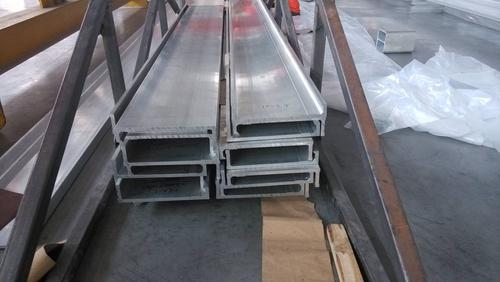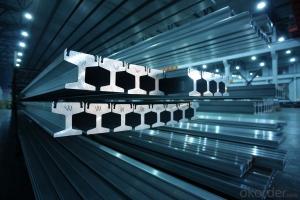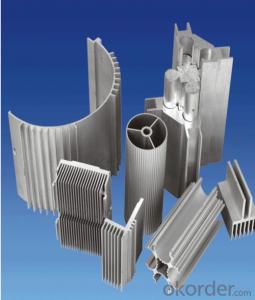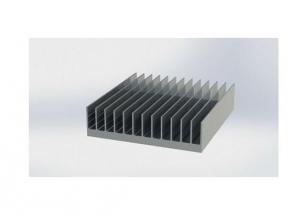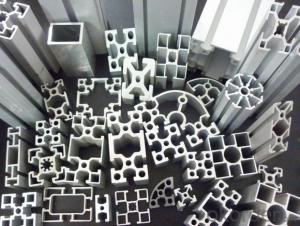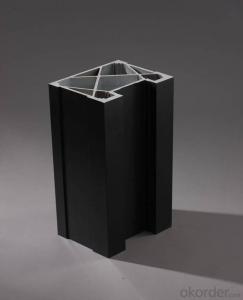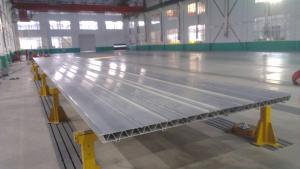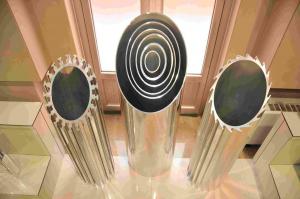Delmar Company Aluminium Profiles for Ship Mast
- Loading Port:
- China Main Port
- Payment Terms:
- TT OR LC
- Min Order Qty:
- -
- Supply Capability:
- -
OKorder Service Pledge
OKorder Financial Service
You Might Also Like
Aluminium Profiles for ship mast
1. Usage:Aluminium Profiles for ship mast
2. Surface: Mill surface treatment
3. Alloy:6082T6 alloy temper
4. Size:various dimensions to meet customer’s requirement
5. Advantage:
The alloy temper of this ship mast is nonheat treatment strengthened alloy which has medium level hardness, good corrosion resistance and weldability. In the atmosphere of sea ocean water, such alloy not only has excellent performance of the general corrosion resistance, and also can eliminate spalling corrosion and inter-granular corrosion.
6. Package:Two pcs of profiles interleaving inserted together to be a couple, ten pcs of profiles wrapped tightly in one bundle.
7. Life time: Last for 50 years
8. Standard: EN755-9 standard
- Q: Knowledge of aluminum profile warehouse management (detail)
- Warehouse management is the main task required under the factories and production equipment condition of overall planning, rational layout; to strengthen the internal economic responsibility system, scientific division, forming material export management guarantee system; business must implement the work quality standardization, application of modern management technology and the ABC classification method, and constantly improve the level of warehouse management. The main work is material inspection, income, inventory, storage and custody of materials, materials delivery, billing statements, etc.
- Q: How much does aluminum mold need?
- The cost of aluminum profile die is judged according to the size of the profile. The length of the profile diagonal and the length of the profile to be produced have direct influence on the die cost. For example, an outer diameter 60mm diameter 40mm of the aluminum tube, in general circumstances, open a diameter of 178mm, thickness of 120mm mold can be produced. But if you request that the length of the aluminum tube produced is 5 meters or longer, this should be a mold with a diameter of 220mm and a thickness of 138mm, so as to squeeze on a larger machine with a larger bar. Of course, this is only one, for example, specific questions should be analyzed in detail.
- Q: This question asks whether aluminum profiles are appropriate for construction in regions with a high risk of earthquakes.
- <p>Aluminum profiles are indeed suitable for use in earthquake-prone areas. They are lightweight, which reduces the overall weight of structures, making them less susceptible to damage from seismic forces. Additionally, aluminum profiles have high ductility and can absorb and distribute seismic energy effectively, enhancing the building's resilience to earthquakes. Their corrosion resistance and durability also contribute to the longevity of structures in such regions. However, it's crucial to ensure that these profiles are properly engineered and installed according to seismic-resistant building codes to maximize their effectiveness.</p>
- Q: This question asks if aluminum profiles are suitable for both exterior and interior uses.
- <p>Yes, aluminum profiles can be used for both exterior and interior applications. They are popular for exterior use due to their resistance to weather and corrosion, making them ideal for construction and architectural projects. For interior applications, aluminum profiles are valued for their strength, lightweight, and aesthetic appeal, often used in furniture, window frames, and decorative elements. Their versatility and durability make them a preferred choice in various settings.</p>
- Q: Is it possible to utilize aluminum profiles in the construction of carports or garages?
- <p>Yes, aluminum profiles can be used for carports or garages. They are known for their durability, corrosion resistance, and lightweight properties, making them ideal for such structures. Aluminum profiles are also easy to install and maintain, and they can withstand various weather conditions without rusting. This material is commonly used for the framing and support structures in carports and garages, offering a cost-effective and long-lasting solution.</p>
- Q: What are the advantages of using aluminum profiles in the aviation industry?
- There are several advantages of using aluminum profiles in the aviation industry. First and foremost, aluminum is a lightweight material. This is crucial in aviation as it helps in reducing the overall weight of the aircraft, which in turn leads to improved fuel efficiency. By using aluminum profiles, aircraft manufacturers can design and construct lighter structures without compromising on strength and durability. Additionally, aluminum exhibits excellent corrosion resistance. This is especially important in the aviation industry where aircraft are exposed to harsh environmental conditions, such as high humidity, temperatures, and saltwater exposure. Aluminum profiles can withstand these conditions, preventing corrosion and ensuring the longevity of the aircraft. Moreover, aluminum profiles offer high strength-to-weight ratio. This means that they provide a strong and rigid structure while remaining lightweight. This property is crucial for ensuring the structural integrity and safety of the aircraft. Aluminum profiles can withstand the stresses and loads experienced during flight, contributing to the overall safety of the aircraft. Furthermore, aluminum is a highly malleable material, making it easy to shape and form into complex designs. This property allows for greater flexibility in aircraft design, enabling manufacturers to create aerodynamic and efficient structures. Aluminum profiles can be easily fabricated, welded, and joined, providing ease of manufacturing and assembly in the aviation industry. Lastly, aluminum is a highly recyclable material. As sustainability becomes increasingly important, using aluminum profiles in aircraft construction helps to reduce carbon footprint. Aluminum can be recycled and reused multiple times without losing its beneficial properties, making it an environmentally friendly choice. Overall, the advantages of using aluminum profiles in the aviation industry include lightweight construction, corrosion resistance, high strength-to-weight ratio, flexibility in design, and recyclability. These properties make aluminum an ideal material for aircraft manufacturing, contributing to improved fuel efficiency, safety, and sustainability.
- Q: Whether aluminum profile of glass curtain wall needs compulsory test?
- Mechanical performance test report of 2. profiles, profile should be imported by the State commodity inspection department inspection certificate.
- Q: This question asks for an overview of the various types of aluminum profiles that are frequently utilized in the field of commercial construction.
- <p>Commonly used aluminum profiles in commercial construction include: 1. Extruded aluminum profiles, which are versatile and can be customized for various applications. 2. Structural aluminum framing, used for building structures and curtain walls. 3. Aluminum window and door frames, known for their durability and energy efficiency. 4. Aluminum handrails and railings, important for safety in commercial buildings. 5. Aluminum trusses, used for roof structures and large spans. 6. Aluminum angles and channels, used for support and framing. 7. Aluminum tubes, used in various structural and decorative applications. These profiles are chosen for their strength, lightweight, corrosion resistance, and ease of maintenance.</p>
- Q: Can aluminum be utilized as a material for constructing railings and fences?
- <p>Yes, aluminum profiles are commonly used for railings and fences due to their durability, low maintenance, and resistance to corrosion. They are lightweight, easy to install, and can be powder-coated in various colors to match architectural styles. Aluminum railings and fences are also appreciated for their strength and ability to withstand harsh weather conditions without rusting or rotting, making them a popular choice for both residential and commercial applications.</p>
- Q: What are the different installation methods for aluminum profiles?
- There are several installation methods for aluminum profiles, including surface mounting, recessed mounting, and corner mounting. Surface mounting involves attaching the profile directly onto a flat surface using screws or adhesive. Recessed mounting involves embedding the profile into a groove or channel in a surface, creating a sleek and seamless appearance. Corner mounting is used to join two profiles at a 90-degree angle, typically using brackets or connectors. Each method offers different aesthetic and functional benefits, allowing for versatile installation options.
Send your message to us
Delmar Company Aluminium Profiles for Ship Mast
- Loading Port:
- China Main Port
- Payment Terms:
- TT OR LC
- Min Order Qty:
- -
- Supply Capability:
- -
OKorder Service Pledge
OKorder Financial Service
Similar products
Hot products
Hot Searches
Related keywords

